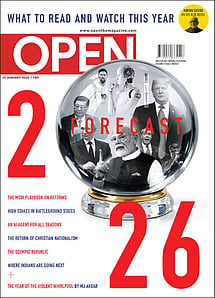It Isn’t Just Trump

IN THE 2003 German film Good Bye Lenin!, the protagonist's mother, a committed East German socialist, falls into a coma in October 1989, awakening eight months later in the summer of 1990. The world outside has changed dramatically and lest she suffer a fatal shock, her son constructs a make-believe world where socialism still lives. The results are comedic. What has happened to India's world in the last eight months reminds one a bit of that wonderful movie.
In January 2025, it was conventional wisdom that India's ties with the US would only strengthen under President Trump. The two had a common adversary in a rising China. Come September, the sight of senior US officials berating India on a daily basis, and Prime Minister Narendra Modi being received warmly by President Xi Jinping in China, is dissonance-inducing, even without a period in coma. How did we get here?
It is tempting to point the finger at Donald Trump. Indeed, his actions are the proximate cause of the scenario India is facing. But the reality is that he is not the root cause of the current tumult. China is. And it is important to recognise that.
The popular revolt against globalisation in the West, of which Trump is a political manifestation, has many dimensions. The excesses of Wall Street, which culminated in the global financial crisis of 2008; porous borders, which resulted in uncontrolled illegal immigration. But at a geopolitical level, at a nation-to-nation level, nothing has been more troublesome than China gaming the "rules-based" system of globalisation to its advantage.
2026 Forecast
09 Jan 2026 - Vol 04 | Issue 53
What to read and watch this year
It used all the non-market instruments at its disposal to take every market economy for a ride. China benefitted from free trade and free markets in the US, Europe, even India, but used opaque or hidden policy measures (in contravention of WTO laws) to support the rise of its manufacturing sector. And not just any rise. It went so big that no other country's industry was left in a position to challenge it.
Trump is right when he says that other countries took advantage of America's openness without reciprocity. But when seen in the context of international trade laws/agreements, most countries played by the rules. Only China egregiously violated both the letter and spirit of the international system.
Ironically, a non-market economy became the biggest beneficiary of the era of free-market globalisation. A backlash was inevitable and some hints of it were visible in Trump's first term and also Joe Biden's term as certain penal actions were directed towards China. But that did not stop China. Its state-backed trade surpluses with the world only grew.
Ultimately, the US decided that it would respond to China's extensive interventions with an industrial policy of its own. Biden initiated it on emerging green technologies where China had achieved a lead. Trump extended it to semiconductors and mineral resources. In the latter, China has
an alarming near-monopoly on the most strategic resources, including rare earth. On the former, it was quickly catching up with the US by copying and then building on US technology.
Unfortunately, Trump's frustration with China spilled over to the rest of the world on the subject of unequal trade. Instead of targeting the main culprit, he opened several fronts. India is always defensive on opening up trade, particularly sensitive sectors like agriculture. But accessing India's dairy
or food market isn't a make-or-break for American prosperity and power. China's use of manipulative policies is.
It seems that China has once again out- manoeuvred America. By turning on its friends in Europe and Asia (Japan, Korea, India), America is distracted from the main culprit. At this rate, China may well win a round it was supposed to lose.
